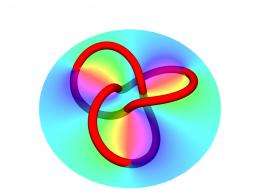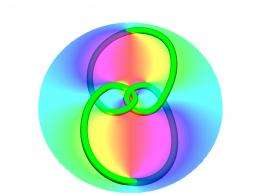Tying light in knots

(PhysOrg.com) -- The remarkable feat of tying light in knots has been achieved by a team of physicists working at the universities of Bristol, Glasgow and Southampton, UK, reports a paper in Nature Physics this week.
Understanding how to control light in this way has important implications for laser technology used in wide a range of industries.
Dr Mark Dennis from the University of Bristol and lead author on the paper, explained: "In a light beam, the flow of light through space is similar to water flowing in a river. Although it often flows in a straight line - out of a torch, laser pointer, etc - light can also flow in whirls and eddies, forming lines in space called 'optical vortices'.
"Along these lines, or optical vortices, the intensity of the light is zero (black). The light all around us is filled with these dark lines, even though we can't see them".
Optical vortices can be created with holograms which direct the flow of light. In this work, the team designed holograms using knot theory - a branch of abstract mathematics inspired by knots that occur in shoelaces and rope. Using these specially designed holograms they were able to create knots in optical vortices.

This new research demonstrates a physical application for a branch of mathematics previously considered completely abstract.
Professor Miles Padgett from Glasgow University, who led the experiments, said: "The sophisticated hologram design required for the experimental demonstration of the knotted light shows advanced optical control, which undoubtedly can be used in future laser devices".
"The study of knotted vortices was initiated by Lord Kelvin back in 1867 in his quest for an explanation of atoms", adds Dennis, who began to study knotted optical vortices with Professor Sir Michael Berry at Bristol University in 2000. "This work opens a new chapter in that history."
More information: Isolated optical vortex knots by Mark R. Dennis1, Robert P. King, Barry Jack, Kevin O'Holleran and Miles J. Padgett. Nature Physics, published online 17 January 2010.
Provided by University of Bristol















